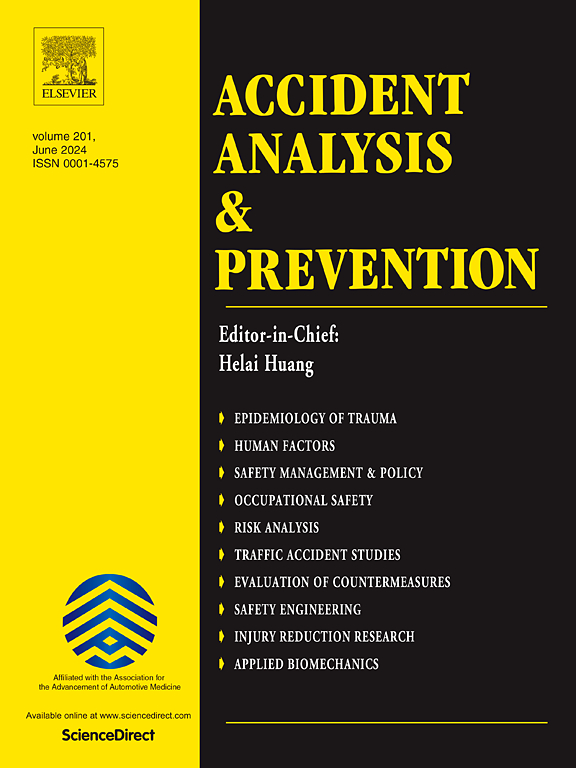Composite safety potential field for highway driving risk assessment
IF 6.2
1区 工程技术
Q1 ERGONOMICS
引用次数: 0
Abstract
In the era of rapid advancements in vehicle safety technologies, driving risk assessment has become a focal point of attention. Technologies such as collision warning systems, advanced driver assistance systems (ADAS), and autonomous driving require driving risks to be evaluated proactively and in real time. To be effective, driving risk assessment metrics must not only accurately identify potential collisions but also exhibit human-like reasoning to enable safe and seamless interactions between vehicles. Existing safety potential field models assess driving risks by considering both objective and subjective safety factors. However, their practical applicability in real-world risk assessment tasks is limited. These models are often challenging to calibrate due to the arbitrary nature of their structures, and calibration can be inefficient because of the scarcity of accident statistics. Additionally, they struggle to generalize across both longitudinal and lateral risks. To address these challenges, we propose a composite safety potential field framework, namely C-SPF, involving a subjective field to capture drivers’ risk perception about spatial proximity and an objective field to quantify the imminent collision probability, to comprehensively evaluate driving risks. Different from existing models, the C-SPF is calibrated using abundant two-dimensional spacing data from trajectory datasets, enabling it to effectively capture drivers’ proximity risk perception and provide a more realistic explanation of driving behaviors. Analysis of a naturalistic driving dataset demonstrates that the C-SPF can capture both longitudinal and lateral risks that trigger drivers’ safety maneuvers. Further case studies highlight the C-SPF’s ability to explain lateral driver behaviors, such as abandoning lane changes or adjusting lateral position relative to adjacent vehicles, which are capabilities that existing models fail to achieve.
公路行车风险评价的复合安全势场
在汽车安全技术飞速发展的时代,驾驶风险评估已成为人们关注的焦点。碰撞预警系统、高级驾驶辅助系统(ADAS)和自动驾驶等技术要求主动实时评估驾驶风险。为了提高效率,驾驶风险评估指标不仅必须准确识别潜在的碰撞,还必须表现出类似人类的推理能力,以实现车辆之间的安全无缝交互。现有的安全势场模型综合考虑了客观和主观两方面的安全因素来评估驾驶风险。然而,它们在现实世界风险评估任务中的实际适用性是有限的。由于其结构的任意性,这些模型的校准通常具有挑战性,并且由于事故统计数据的稀缺性,校准可能效率低下。此外,他们还努力概括纵向和横向风险。为了应对这些挑战,我们提出了一个复合安全势场框架,即C-SPF,该框架包括一个主观场来捕捉驾驶员对空间接近的风险感知,一个客观场来量化即将发生碰撞的概率,以综合评估驾驶风险。与现有模型不同,C-SPF使用来自轨迹数据集的丰富二维间距数据进行校准,使其能够有效捕获驾驶员的接近风险感知,并提供更真实的驾驶行为解释。对自然驾驶数据集的分析表明,C-SPF可以捕获触发驾驶员安全操作的纵向和横向风险。进一步的案例研究表明,C-SPF能够解释驾驶员的横向行为,例如放弃变道或调整相对于相邻车辆的横向位置,这些都是现有模型无法实现的功能。
本文章由计算机程序翻译,如有差异,请以英文原文为准。
求助全文
约1分钟内获得全文
求助全文
来源期刊

Accident; analysis and prevention
Multiple-
CiteScore
11.90
自引率
16.90%
发文量
264
审稿时长
48 days
期刊介绍:
Accident Analysis & Prevention provides wide coverage of the general areas relating to accidental injury and damage, including the pre-injury and immediate post-injury phases. Published papers deal with medical, legal, economic, educational, behavioral, theoretical or empirical aspects of transportation accidents, as well as with accidents at other sites. Selected topics within the scope of the Journal may include: studies of human, environmental and vehicular factors influencing the occurrence, type and severity of accidents and injury; the design, implementation and evaluation of countermeasures; biomechanics of impact and human tolerance limits to injury; modelling and statistical analysis of accident data; policy, planning and decision-making in safety.
 求助内容:
求助内容: 应助结果提醒方式:
应助结果提醒方式:


